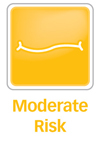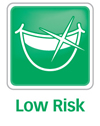Is your diet affecting your teeth?
How the foods you eat can affect your oral health.
Cavity Risk Factors
Number of meals and snacks
Fact: Frequent exposure to foods high in fermentable carbohydrates (sugars and starches) provides bacteria with more opportunities to produce acid.
- Limit meals and snacks to six or fewer times per day.
Meal and snack structure
Fact: An unstructured meal and snack pattern (irregular eating) is associated with more frequent and longer exposures to foods high in fermentable carbohydrates, and provides bacteria with more time to produce acid.
- Eat foods and beverages at about the same time every day.
- Eat foods and beverages during a few 30-minute time periods each day.
Sugared beverages
Pop, soda, 100% juice, juice drinks, sports drinks, energy drinks, flavored water with sugar, sugared coffee or tea
Fact: Drinking multiple sugared beverages increases the frequency of fermentable carbohydrate exposure, and provides bacteria with more opportunities to produce acid.
Fact: Sipping sugared beverages throughout the day increases the length of exposure to fermentable carbohydrates, and provides bacteria with more time to produce acid.
- Limit sugared beverage intake to 12 ounces total per day.
- Drink sugared beverages with foods at meals or snacks.
- Drink sugared beverages within a 1 minute time period.
- Select sugar-free (unsweetened or artificially sweetened) beverages. Sugar-free beverages do not contain fermentable carbohydrates, and bacteria cannot use them to produce acid.
My Cavity Risk
| Risk Factor | Current Behavior | Recommended Behavior |
# Meals
#Snacks | ____ Meals
____ Snacks | 3 meals per day
1-3 snacks per day |
| Meal/Snack Structure | Structured
Unstructured | Structured meal pattern |
Sugared Beverages
Pop & Soda
100% Juice
Juice drinks
Sports drinks
Energy drinks | ____ per day
____ounces
+ / - meals
____minutes
+ / - sugar-free | Drink ≤ ounce a day
Limit to ≤ 12 ounces
Drink with meals
Drink in ≤ 15 minutes
Replace with sugar-free beverages |
| Candy & Lozenges | ____ per day
+ / - meals | Limit to once a day
Consume with meals |
| Cavity Risk | Food Category |
 | Sugared beverages: regular pop/sodas, fruit drinks, fruit juices
Bakery goods: cookies, brownies, cakes, cereals
Candies: chocolate bars, caramels, hard candies |
 | Snack foods: potato chips, tortilla chips, crackers
Dried and canned fruits: raisins, banana chips, fruits in syrup
Dairy with sugar: flavored milk, sugar-sweetened yogurt, pudding, ice cream |
 | Grains: whole-wheat breads, bagels, pasta, rice
Vegetables: fresh and frozen vegetables
Fruits: fresh fruits
Dairy: milk, cheese, yogurt without sugar
Meats: beef, pork, poultry, nuts, beans |
Eating tips to lower cavity risk
- Limit intake of high risk foods and beverages to one serving per day.
- Eat high risk foods with meals and snacks.
- Drink high risk beverages within 15 minutes.
- Drink high risk beverages with meals or snacks.
- Chew sugar-free gum or rinse with water after drinking high risk beverages or eating high risk foods.
Preventing Cavities By Limiting Fermentable Carbs
Bacteria are naturally present in everyone's mouth. Bacteria eat carbohydrates found in foods and beverages, and produce acids that dissolve the tooth structure. Bacteria prefer "fermentable" carbohydrates - sugars and processed starches that are easy to eat.
In addition to brushing and flossing regularly, practicing good eating habits and choosing healthy foods can reduce your cavity risk. The goal of practicing good eating habits and choosing healthy foods it to limit the number and length of exposures to fermentable carbohydrates. Fewer and shorter exposures to fermentable carbohydrates decrease bacteria's ability to produce acid. Less acid production leads to less tooth destruction - no cavities!
